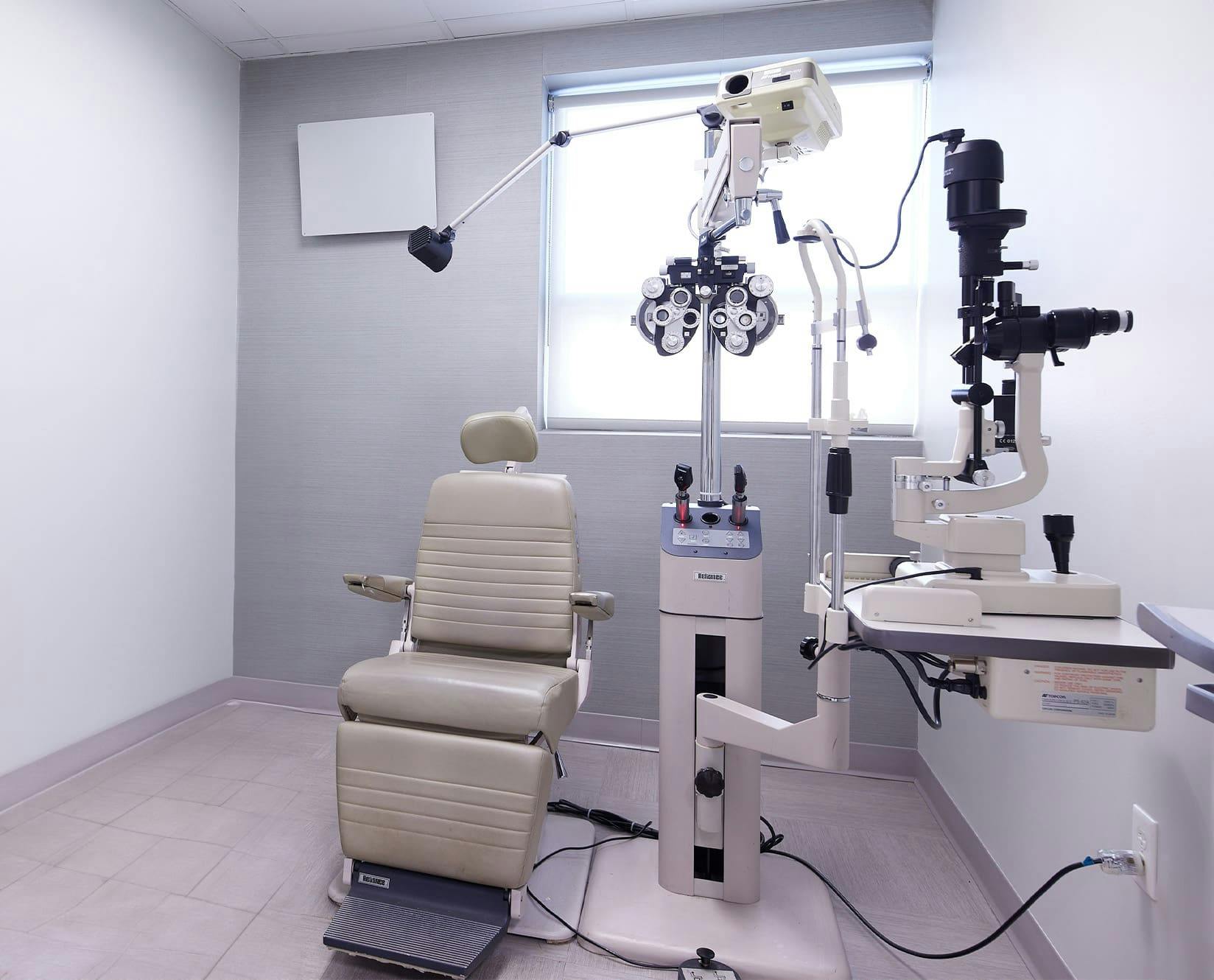If you’ve been looking into laser eye surgery to improve your vision, you’ve probably come across some terms that you’re unfamiliar with. Learning common LASIK terms can help you better understand any information you might come across while reading about LASIK and PRK surgery definitions.

Glossary of Terms
Below, you’ll find some of the LASIK terminologies you’re likely to come across. With these common LASIK terms and definitions, you’ll be able to get a clearer understanding of the LASIK acronym, or LASIK meaning, so that you understand the procedure a bit better.
Aberrations: Refractive errors caused by the lens that result in vision-blurring or distortion.
Acuity: The sharpness or clarity of vision. This is what is measured when optometrists talk about a visual acuity of 20/20.
Astigmatism: A common visual problem describing a distorted retinal image caused by an eye that is not perfectly round. An eye with an irregularly curved cornea or lens has astigmatism, which typically results in difficulty seeing fine details.
Bladeless LASIK: A type of laser eye surgery in which the eye surgeon uses an Intralase laser to create a corneal flap to perform the vision correction procedure.
Cataract: A condition in which protein clumps cloud the eye’s lens, which then blocks the passage of light to the retina and causes impaired vision. This is a common age-related condition that affects more than half of Americans aged 65 and older.
Cornea: The transparent, curved surface through which light enters at the front of the eye. The cornea covers the iris and pupil and helps focus light into the retina at the back of the eye. This is what is reshaped during LASIK surgery.
Corneal epithelium: This is the soft, protective surface tissue that encases the eyeball. This thin layer of cells is the eye’s first defense against infection but also heals quickly.
Corneal flap: This is a thin slice of tissue made to create a flap on the surface of the cornea at the beginning of a LASIK procedure. The corneal flap is folded back to allow the surgeon to reshape the inner layers of the cornea.
Custom LASIK: A custom LASIK procedure allows a surgeon to create a personalized procedure based on the results of wavefront mapping to address the unique vision needs of each eye.
Diopter: A unit of measurement used to describe a refractive error. A negative diopter indicates nearsightedness, while a positive diopter indicates farsightedness.
Excimer laser: An ultraviolet, or “cold,” laser used during refractive surgeries to remove corneal tissue and reshape the surface of the cornea.
Farsightedness: This common refractive error occurs when the eye is too short or there is too little curvature of the cornea to focus light correctly onto the retina. Also called hyperopia or hypermetropia, farsightedness results in blurred vision up close, while distance vision remains crisp and clear.
Ghost image: A faint second image of an object being looked at.
Glare: Caused by bright light, glare causes light to scatter within the eye, rather than coming into focus, which makes it difficult to see. This higher-order aberration often occurs naturally, but it can also be caused by cataracts, other eye conditions, or as a side effect of LASIK.
Halos: The appearance of rings around lights at night. This higher-order aberration often occurs naturally, but may also be caused by cataracts, other eye conditions, or as a side effect of LASIK.
Haze: This is caused by corneal clouding and creating the sensation of looking through fog or smoke.
Higher-order aberrations: Refractive errors that cannot be corrected with typical glasses or contacts. Wavefront technology allows these errors to be addressed by some vision correction options, including laser vision correction procedures.
Hyperopia or hypermetropia: Other terms for farsightedness. Symptoms can include blurry close-up vision, eye strain, and squinting.
Iris: The colorful ring of tissue suspended behind the cornea and just in front of the lens that manipulates the size of the pupil and regulates the amount of light entering the eye.
Keratectomy: The surgical removal of corneal tissue to reshape the cornea.
Keratitis: Inflammation of the cornea.
Keratomileusis: Another term for reshaping the cornea.
Keratotomy: A surgical incision of the cornea.
Laser keratome: A laser device used to create a corneal flap.
LASIK: The LASIK acronym stands for laser-assisted in situ keratomileusis. LASIK is a procedure during which a corneal flap is created and the cornea is reshaped using a laser to correct vision.
Lens: The transparent disc behind the pupil that focuses light on your retina. The lens can change shape to focus at different distances. It does this by relaxing to focus on objects in the distance, or contracting to focus on objects up close.
Microkeratome: A surgical instrument using a thin blade to make the corneal flap at the beginning of a LASIK procedure.
Monovision: A vision correction in which one eye is deliberately corrected for distance vision and the other for close vision.
Myopia: Another term for nearsightedness, this common refractive error occurs when the eye is too long or there is too much curvature of the cornea, causing light to focus in front of the retina rather than on it. Nearsightedness results in blurred distance vision, while close-up vision remains crisp and clear.
Nearsightedness: The common term for myopia. Symptoms can include blurry distance vision, eyestrain, poor night vision, and squinting.
Ophthalmologist: A medical doctor or doctor of osteopathy qualified to diagnose, manage, and treat all eye and visual system disorders and diseases. Ophthalmologists are trained to offer complete eye care, from eye examinations to medical and surgical eye care, including correctional contact lenses or glasses and prescribing medications.
Optician: A professional who makes and fits glasses.
Optometrist: A primary eye care provider who can provide basic eye health and vision exams, prescribe glasses, contact lenses, and medications, as well as diagnose, manage, and treat eye disorders and diseases.
Overcorrection: A refractive surgery complication in which the eye is corrected too much.
Photorefractive keratectomy (PRK): A procedure involving the removal of the surface layer of the cornea so that the curvature of the stroma can be reshaped by laser.
Presbyopia: A natural condition of aging when the lens loses its elasticity, making it harder to focus on fine details, small print, or things up close.
Pupil: The black, circular hole in the center of the eye’s iris that constricts and dilates to regulate the amount of light entering the eye. The size of your pupil adjusts in response to light conditions.
Refraction: The bending of light as it passes from one medium into another. Also, a test that determines the refractive power of the eye, identifying the lens power needed for ideal visual acuity.
Refractive error: Irregularities in the shape or curvature of the cornea, lens, or eye that prevent the eye’s proper focusing power.
Retina: The transmitter blood vessels and nerve tissue at the back of the eye that acts like the film in a camera, capturing and transmitting images from the eye to the brain via optic nerves.
Sclera: The tough white outer layer of the eyeball that, with the cornea, protects the eyeball.
Starbursts: This gives the appearance of rays of light coming off a light source.
Stroma: The cornea’s middle layer.
Undercorrection: A refractive surgery complication in which the eye is not corrected enough.
Vitreous humor: The transparent gel that fills the center of the eyeball behind the lens and in front of the retina.
Wavefront: Measures the visual capacity of the cornea and refractive errors of the eye by transmitting a ray of light into the eye which is reflected off the retina and back out through the pupil. The device captures the reflected wave of light on a 3D map, called a wavefront map, to accurately determine the eye’s unique refractive errors.
